Overview:
The European Retrievable Carrier (EURECA) was launched 31 July 1992 by the Space Shuttle Atlantis, and began its scientific mission on 7 August 1992. It was retrieved on 1 July 1993 by the Space Shuttle Endeavor and returned to Earth. The satellite carried a number of experiments for microgravity studies, solar observations, and material technology investigations.
It has been retrieved by the Space Shuttle in June 1993 after 326 days in space (~11 months exposure) at an altitude around 500 km and an orbit of 28.5 degrees. The total exposed surface area is about 140 square metres.
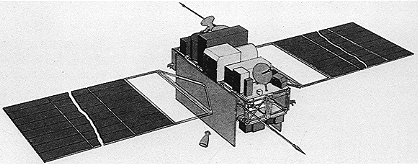
Figure 1: Eureca Schematic Draft
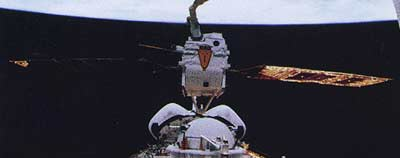
Figure 2: Eureca in Space
Multi-Layer Insulation Analysis:
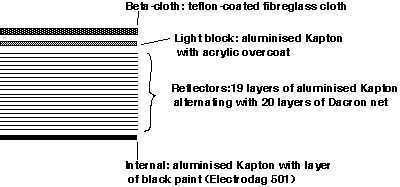
Figure 3: Build-Up of Multi-Layer-Insulation
The conclusions of the MLI analysis can be summarised as follows:
- Morphology of impact damage depends heavily on the surface impacted and the size of the impacting particle.
- The following morphologies were observed:
- Betacloth melts and breaks giving an irregular hole.
- The Teflon layer around the hole is shattered and ejected, producing small pieces of Teflon and loose fibres.
- Paint shatters, not necessarily at the interface between paint and aluminium.
- 75 µm Aluminised Kapton chars and decomposes giving a circular hole.
- 7.5 µm Aluminised Kapton chars and tears leaving a ragged hole with cracks leading from it.
- Dacron net melts leaving blackened ends.
The EU-293.ac0.2 impact remained in the first layer of the plume impingement shield (layer thickness 280 µm). The EU-143.g2.1 impact penetrated eleven layers of type 6 MLI (total thickness 352.5 µm). The EU-119.db2.1 impact penetrated the first layer of the type 6 MLI (layer thickness 210 µm).
No deductions on the sizes of the impactors can be made until the results of recent calibration experiments have been analysed. However, it seems safe to say that the EU-143.g2.1 had more momentum than the other two impacts.
Chemical characterisation was complicated by the vast array of different elements in the blanket materials. Pieces of shattered Teflon, broken glass fibres and strands of Dacron net were littered around the impact sites on the type 6 MLI. Organic salts and minute pieces of stainless steel were also found.
It seems that the impact EU-119.db2.1 may have been caused by an aluminium impact particle. In order to confirm or deny this, it is planned to make a detailed analysis using ESCA surface analysis on the second layer of the blanket.
The EU-143.g2.1 impact shows signs of being caused by a particle containing Si, Ca, Al, Mg, S, O. The residues seen were usually in the form of droplets. Unfortunately the glass fibre composition is also: Si, Al, Ca, Mg, O. In order to distinguish whether the droplets are simply melted bits of glass fibre or some sort of silicate micrometeoroid, further analysis is necessary. The residues are too small for a Transmission Electron Microscope examination of the crystal structure, but an ESCA surface analysis may provide conclusive information.
It was found impossible to deduce anything from the analysis of EU-293.ac0.2. No residues were detected.
- Impact events are readily detected in the MLI blankets from EURECA.
- The holes range in size from a mean diameter of ~ 60mm to ~ 1200mm. Most holes are generally ellipsoidal in shape, implying oblique impact by the particles.
- The distribution of hole sizes is approximately bimodal, with maxima at 250 - 350 mm (n = 20; 32%) and 400 - 500 mm (n = 11; ~ 18%).
- The cumulative impact flux distribution (although not corrected for impact substrate) is similar to that determined for LDEF.
- In Type 6 MLI, there is a positive correlation between the size of the impact hole into the top, beta-cloth, surface, and the number of layers subsequently penetrated. This observation is consistent with the largest holes being made by the particles with the highest energy (either due to high mass or velocity).
- Beta-cloth contains the same major elements (Si, Al and Ca) as many natural micrometeoroids, thus MLI surfaces are not a good medium for the effective capture of natural samples for subsequent study.
- Particles were readily detected within most blankets. Individual penetration features often contained many particles, and these might be of different chemical compositions. The particles were not always close to the impact feature itself.
- Chemical analysis of particles associated with impact holes indicated that ~ 7% were natural micrometeoroids, and 43% were pieces of beta-cloth carried into the interior of the blankets as a result of the impact. The remaining particles are space debris of some form.
- Normalising the chemical analyses to a "per hole" basis, ~ 8% of the features were produced by natural micrometeoroids and ~ 34% by space debris. The remaining 58% of the holes cannot be assigned a specific origin.
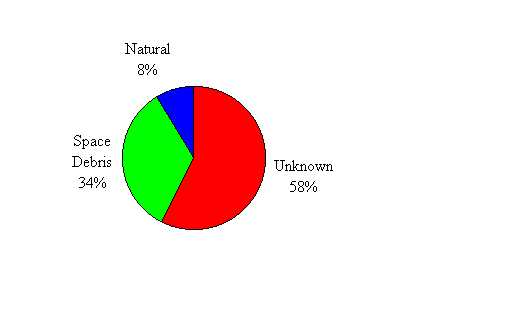
Figure 4: Particle type distribution
Solar Cell Analysis:
The retrieved EURECA solar arrays offer 95 m2 of uniformly-oriented meteoroid and debris detecting surfaces. This was an unprecedented opportunity to investigate various aspects of meteoroid and debris flux in low-Earth orbit (LEO).

Figure 5: Solar cell materials
The solar arrays consist of 2 wings of 5 panels (each panel measuring 1.4 x 3.4 m x 22 mm thickness). In this work a high resolution microscopic impact survey of one of the panels was performed. The size distribution and crater morphologies of impacts smaller than 500 µm on the front side of the panel are described. These small impacts form a consistent data set as they are almost all craters in the protective CMX cover glass of the solar cells. The impacts larger than 500 µm in spall diameter tend to be holes and their morphologies are consequently affected by the different materials behind the cover glass and solar cells. The flux derived from the impact survey is compared to existing data from LDEF and other experiments and to model predictions, calculated using the ESABASE Meteoroid and Debris tool.
The study of micro-impacts on the EURECA solar panels provides an interesting comparison to the morphology of craters already found on glassy lunar rocks, Apollo and Shuttle windows. It provides data in the poorly-known microparticulate region of flux curves. This will eventually help to clear up the ambiguities in LDEF micro-impact data and improve current flux models.
A single solar panel from the EURECA solar generator was examined for impacts caused by micrometeoroids and orbital debris in LEO. Our video microscope permitted detection of impacts as small as 30 µm across (spall diameter). For this size, a flux equivalent to 3000 impacts on this one panel for the 11 month mission was found. The craters showed morphologies similar to microimpacts previously observed on Apollo and Shuttle windows and on lunar rocks, with the smallest impacts displaying a large shocked zone and little spallation and the larger impacts displaying a smaller shocked zone and more spallation. The 150 µm thick glass coverslide was penetrated for spall diameters above approx. 800 µm and so could be said to protect against debris particles of less than 55 µm and meteoroid particles of less than 95 µm in diameter (using Gault's equation). The EURECA expected particle flux was modelled using GrÙn's meteoroid and Kessler's debris empirical distributions and found to compare well with measured flux values. More research is in progress on the conversion between particle and crater dimensions, submicron particle flux and the origin of individual impacts.
Final Fluxes:

Figure 6: Final fluxes
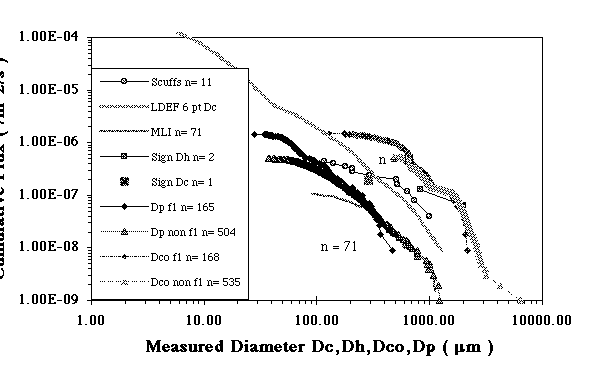
Figure 7: Final fluxes
Meteoroids vs Debris:
Concerning Space Debris, and the "meteoroids versus debris" argument, EuReCa promises, by analysis of the MLI cored sections, to offer good scope for the elemental analysis of residues vital to their discrimination. Some 63 sites should be available for analysis, and their pointing direction will assist inputs into modelling of the flux distribution.
Summary Results/Conclusions:
Damage from the solid particle population of the near Earth Space environment has been assessed on a number of key space materials. Though previously retrieved space systems have been more diverse, EuReCa has offered a unique assessment of the damage on cover glasses and solar cell arrays, on Kapton and on MLI beta-cloth. Extending to a high mass by virtue of the axis-time product this compliments the LDEF data, which refers to a dominantly aluminium target. EuReCa's epoch of exposure 1992/93, being some 5 years later than LDEF, also offers opportunity for assessment of flux time variations and essential input into modelling which can be performed by e.g. ESABASE.
EuReCa's directional flux data established in these studies is not definitive regarding the "debris versus meteoroids" argument. From the crater morphology we see evidence of low density and high velocity, especially in the larger sizes of crater (several millimetres). But there are trends in the crater morphology ratios at smaller size which appear to indicate 1) wider range of impactor density and 2) a higher value of density.
Exceptionally, for hypervelocity impacts on exposed flat surfaces, a large number of impact sites showed evidence of impactor directionality, requiring impacts at high angles substantially from the normal, perhaps greater than 70°. Whereas such a high fraction has not been noticed before on metallic targets (e.g. LDEF) it remains to be seen whether this is due to almost grazing incidence on the solar cells or to an unsuspected susceptibility of solar cells in revealing non-normal impacts. Important analysis ahead to utilise this data are recommended: 1. Chemical analysis of the MLI perforations and a selection of other surfaces. 2. Laboratory impact, especially by low density projectiles, of both solar array samples and Kapton; inputs must be at normal and inclined angles 3. Comparison with LDEF solar cell morphology data, thus providing information on exposure geometry effects for different stabilisation modes (LDEF being geocentric; EuReCa heliocentric). A number of these studies have been initiated by the European Space Agency.

